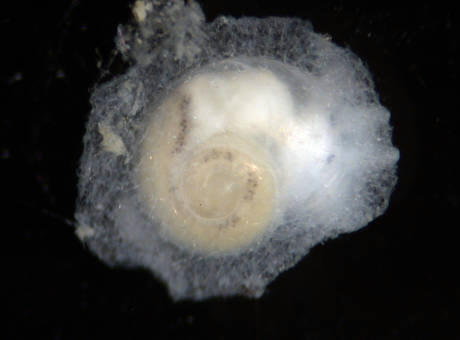
Vermi fino 3 chilometri sottoterra.
Megalonematodi.
(ANSA) - MILANO, 1 GIU - Vivono in un ambiente ben diverso da quello che si
trova in superficie e dove pressione e temperatura sono altissime: per questo
sono dei veri e propri 'alieni', i vermi che vivono fino a tre chilometri di
profondita' nel sottosuolo. Finora gli unici esseri viventi noti per vivere in
condizioni cosi' estreme erano organismi semplicissimi come i batteri. Questi
vermi, battezzati 'nematodi' sono stati scoperti, grazie a una ricerca dell'universita'
belga di Ghent, nel sottosuolo sudafricano.

Nulla di strano se pensiamo che un bel po di anni fa, Frank
Herbert, se vi ricordate, lo scrittore di fantascienza, che la sapeva lunga in
fatto di conoscenze esoteriche,
parla di un mondo dove vivono i grandi vermi. L'unico pianeta nell'universo dove
è reperibile la spezia. Questi misurano mezzo millimetro magari, ma sono capaci
di vivere parecchio in profondità.
Per conoscenza, allora andatevi a rivedere il film, e capirete quello che sto
per dirvi in modo più chiaro. No, non vi darò la soluzione. Scordatevela, ma
inserirò su questa pagina alcune delle variabili dalle quali partire per
comprendere meglio quali segreti avrebbe nascosto Arrakis, e nel caso, questo
fossero anche stati taciuti a noi.
Vi parrà strano, e naturalmente, prenderete la notizia come la solita
stupidaggine che avete trovata in rete, ma sappiate che a questo punto,
essendovi dimostrati la razza più credulona del quadrante, dal momento che tutti
ridono di noi, non potrà nuocervi gravemente l'aggiunta di questo piccolo
dettaglio.
Questa è una domanda che sorge spontanea, non appena si da una occhiata a questa fotografia. La didascalia dice:
What are those things? They were first seen in 1998; they don't look like anything we have here on Earth. To this day, no one is sure what they are, but we now know this: They come, then they go. Every Martian spring, they appear out of nowhere, showing up — 70 percent of the time — where they were the year before. They pop up suddenly, sometimes overnight. When winter comes, they vanish.
Come vedere, gli unici a credere che siate soli nell'universo
siete rimasti voi, ed è un bene, perchè significa che tutti gli altri si sono
svegliati.

Vi ingrandisco uno dei tunnel prodotti quando emergono e
rientrano sotto terra. Questo è un segno evidente che potrete trovare un po
dappertutto, su quei pianeti che pensate disabitati, come pure quelli che a voi
paiono senza atmosfera, e allora non dovrebbero avere vista secondo i vostri
canoni. Quanta limitatezza mostra il vostro pensiero e con quanta arroganza vi
curate del vostro pregiudizio, è una cosa mai vista. Fate pure. Vi ricordo
comunque che queste sono foto che voi potete vedere solo oggi, mentre sono
informazioni note che circolavano già nel 1968. Forse siete un poco in ritardo.
L'ingrandimento.
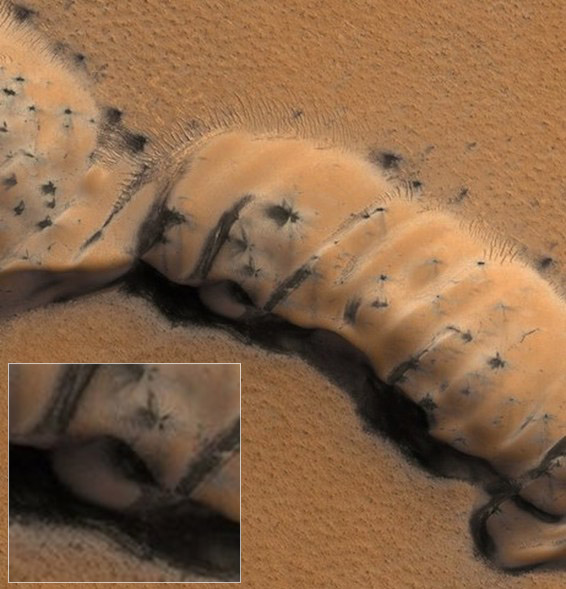
As the sun gets hotter, they get more spidery. Here's a closer image — like the one above, this gorgeous print was created by the photographer Michael Benson, just published in his new book, Planetfall. It shows two mounds of sand. The spidery thingies, you'll notice, stay on the rises, not on the flat sandy plains. What could they be? Scientists from the U.S. Geological Survey, from Hungary, from the European Space Agency have all proposed explanations; the leading one is so weird, it's transformed my idea of what it's like to be on Mars. For 20 years, I've thought the planet to be magnificently desolate, a dead zone, painted rouge. But imagine this: Every spring, the sun beats down on a southern region of Mars, morning light melts the surface, warms up the ground below, and a thin, underground layer of frozen CO2 turns suddenly into a roaring gas, expands, and carrying rock and ice, rushes up through breaks in the rock, exploding into the Martian air. Geysers shoot up in odd places. It feels random, like being surprise attacked by a monstrous, underground fountain. Here's what it might look like:
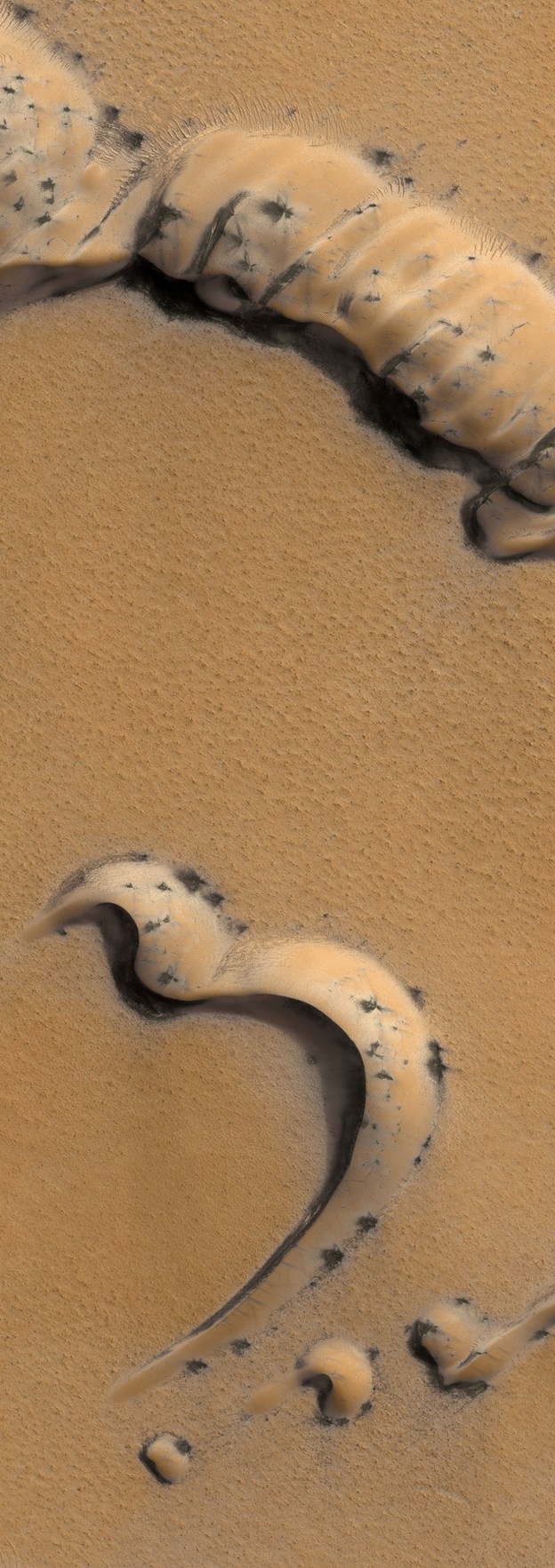
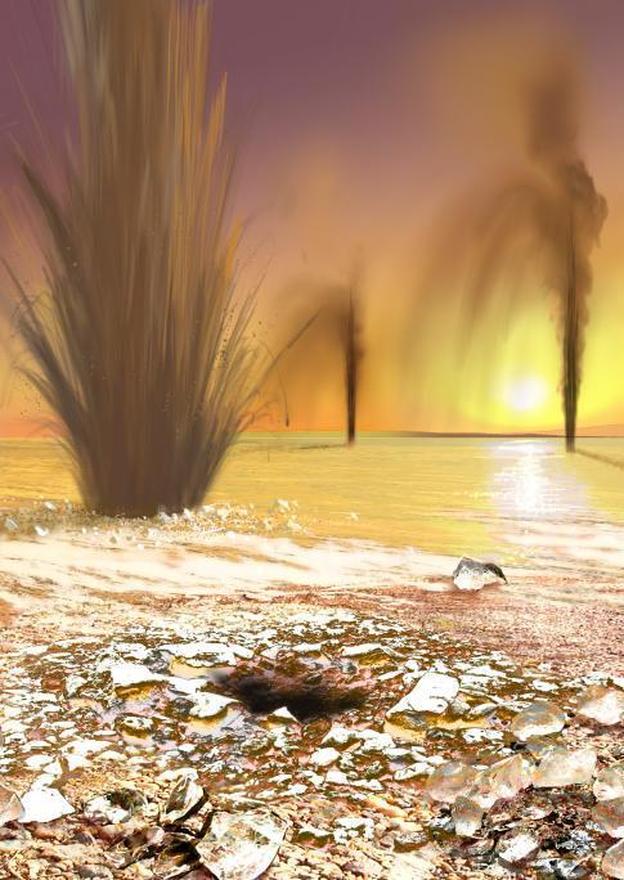
Che farebbero pensare naturalmente per similitudine agli spruzzi delle balene. Compreso?
Anche se perlopiù gli studiosi che hanno analizzato le foto,
hanno dato altre spiegazioni. Interessanti, ma non proprio azzeccate.
"If you were there," says Phil Christensen of Arizona State
University, "you'd be standing on a slab of carbon dioxide ice. All around you,
roaring jets of carbon dioxide gas are throwing sand and dust a couple hundred
feet into the air." The ground below would be rumbling. You'd feel it in your
space boots. That, anyway, is the leading explanation. The spidery traces that
you see in Michael's two prints might be clumps of dark, basaltic sand thrown
from the geysers. Or — say a group of Hungarian scientists — they might be
colonies of photosynthetic Martian microorganisms, warmed from the sun,
now sunbathing in plain view. We still don't know for sure.We've been watching
those spider patches come and go for the last decade or so, and for a little
while longer, we will have to guess why they're there, or what they're telling
us.
Suvvia, foto di micro organismi? Non sembrano affatto micro. Proviamo con macro?
Ora studiatevi questa altra immagine, e alla luce delle conoscenze che dovreste
avere acquisite dopo aver letto alcuni dei articoli che ho scritto. Applicate i
principi della risonanza e studiate le curve presenti nell'immagine. Avete
trovato nulla? Ricordate il metodo per trovare nuvole bizzarre nel cielo,
generate da impianti scalari?Fate lo stesso ora, rammentando che si tratta di
sabbia, e che le spinte meccaniche dovranno essere prodotte da spinte
incommensurabilmente più grandi, incalcolabili dal nostro punto di vista, ma
semplicemente possibili qualora un grande verme si scuota, si distenda o attui
il suo richiamo. Nella zona nera c'e' una spinta lenta, caratterizzata da onde
di entità più grande e collocate esattamente sullo stesso asse. Poco più in
basso, la prova che qualcosa di bizzarro ha generato un sistema risonante di
guglie appuntite, con una onda smorzata. Ecco il richiamo. Non vi capiterà di
vederlo spesso. Ma se lo sentite, vi avverto, che sarà brutto segno. Dalla
misura esatta di questo tipo di conformazione particolare, potreste comprendere
facilmente di quale suono si tratta, mentre calcolando la sua propagazione nel
terreno, e successiva nell'atmosfera, potreste magari avere una idea del suono
terrestre della cosa. Ma per facilità vi indicherò un metodo più facile. Puntate
un sistema di quelli utilizzati per la radioastronomia sulla superficie del
pianeta, ma concentrate la vostra attenzione non sui giga hertz, ma sulla banda
ELF, VLF. Quando troverete quella stessa propagazione elettrica, sarete in
presenza dei grandi Vermi, potrete traslare il suono a livello uditivo, e quindi
ascoltarlo da voi. Prima, come sempre terminano certi articoli beceri, si diceva
"chissà cosa vogliono dirci...", e la risposta più semplice è che non vogliono
dirci nulla, ma dipende tutto da come vediamo le cose.

Qui in basso a destra il segno distintivo del richiamo.
Finalmente la scienza si ricorda di qualcuno, anche se resta
come al solito su proporzioni adeguate alla propria misura. Ancora i limiti
della conoscenza e della comprensione umana.
Giant Tube Worm
(Riftia pachyptila)
The giant tube worm, also known as Riftia pachyptila, was totally unknown to
science until researchers exploring the deep Pacific Ocean floor discovered
strange, hydrothermal vents. Powered by volcanic heat, these vents recirculate
water that seeps down through cracks or faults in the rock. When the water
emerges from the vent, it is rich in chemicals and minerals. This toxic soup of
chemicals would be lethal to most animals, so scientists were shocked to find
entire ecosystems of animals living around these vents. In spite of the near
boiling temperature of the water, these animals were thriving in the complete
absence of light. The organisms that live near these vents are unique because,
unlike all other living things on earth, they do not depend on sunlight for
their source of energy. Instead, they feed on tiny bacteria that get their
energy directly from the chemicals in the water through a process known as
chemosynthesis. These hydrothermal vents are known as "black smokers" because of
the dark color of the material they eject. The giant tube worms are closely
related to the many smaller species of tube worms that inhabit shallower waters.
These giant tube worms grow up to eight feet (over two meters) in length and
have no mouth and no digestive tract. They depend on bacteria that live inside
them for their food. This type of mutually beneficial relationship between two
organisms is known as symbiosis. The bacteria actually convert the chemicals
from the hydrothermal vents into organic molecules that provide food for the
worm.
Perhaps the most noticeable characteristic of these worms is their bright red
plume. This is a specialized organ used for exchanging compounds such as oxygen,
carbon dioxide, and hydrogen sulphide with the seawater. The bright red color
comes from the presence of large amounts of hemoglobin (blood). It is this plume
that provides nutrients to the bacteria that live inside the worm. The outer
tube of the worm is made from a tough, natural substance called chitin. Chitin
is also the main component in the exoskeletons of crabs, lobsters, and shrimp.
Although the worms have no eyes, they can sense movement and vibrations and will
retreat into their protective tubes when threatened.
Giant tube worms reproduce by releasing their eggs into the water to be
fertilized. After hatching, the young larvae swim down and attach themselves to
rocks. As the larvae develop into tiny worms, they temporarily develop a
primitive mouth and gut through which the symbiotic bacteria enter. As the worm
grows older, the mouth and gut disappear, trapping the bacteria inside.
Giant tube worms have been found throughout the Pacific Ocean where deep sea
hydrothermal vents have been discovered. The average depth of these vents is
5,000 feet (1,500 meters). Entire communities of shrimps and crabs have been
found living around these giants. It is believed that these invertebrates feed
by nibbling off bits of the tube worms' red plumes. As amazing as these vent
ecosystems are, they are also extremely fragile. As the Earth's crust shifts due
to geothermal activity, the supply of chemicals through the vents can be cut
off. When this happens, all of the incredible creatures that depend on these
chemicals will wither and die. Scientists have returned to once thriving vent
sites only to find them completely cold and dead. But the cycle begins again
when new hydrothermal cents begin to grow elsewhere on the deep sea floor.
Ammetterlo è già un bel passo avanti, ma non basta. Ma dato che vedo che siete ancora scettici, vi aggiungo anche questo altro articolo.
Scientists digging 2.2 miles under South Africa didn’t crack
through the roof of Hell, but they did find the “devil worm,” the deepest-living
animal known.
Halicephalobus mephisto, a newly discovered species named
for Faust’s Mephistopheles, is the first nematode found beyond the 100-meter
mark.
Depths beyond that were thought to harbor only microbes. But where there are
microbes, there is probably something to eat those microbes, and that’s where
the devil worm comes in.
The 1/2-millimeter worms have evolved to the withstand the intense pressure and
heat of living deep underground. “That sounds small, but to me it’s like finding
a whale in Lake Ontario,”
Tullis Onstott, a geomicrobiologist at Princeton, told National Geographic.
“These creatures are millions of times bigger than the bacteria they feed on.”
National Geographic has a photo of the critter.
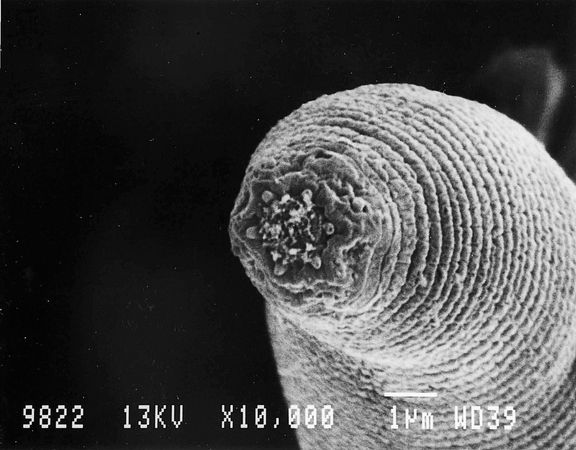
The worm was first discovered in a South African gold mine, but scientists weren’t
sure if it was carried in by miners. Gaetan Borgonie of Belgium’s University of
Ghent began boring samples from mines and eventually found the worms. Onstott
hopes the discovery prompts more searches for life in extreme conditions.
“People usually think only bacteria could exist below the surface of a planet
like Mars,” Onstott said told National Geographic. “This discovery says, ‘Hold
up there!’”
E finalmente qualcuno ci pensa, che anche lassù... ma la discrepanza se l'avete
notata, è che la taglia del verme in questione è di una decina di nanometri,
mentre quello che vediamo su marte misura qualche chilometro a dir poco, e il
bello è che ogni volta che ne parlano continuano ad accostare la cosa. Se si
trattasse di vermi da un nanometro e potessero vederli significherebbe o che
hanno telescopi davvero eccezionali e che ci stanno mostrando solo foto per
prenderci in giro, o che i vermi di cui si parla sono leggermente più grandi, in
condizioni diverse da quelle che consideriamo di solito. E cioè strati della
crosta terrestre ove le temperature sono maggiori, e la gravità minore come si
afferma in un gran numero di testi sacri dell'antichità. ( Vi ricordo che sotto
il fiume tevere, ce ne è un secondo ad una certa profondità, che è di sette
volte più grande, e cio' significa che sotto il derma dove possiamo trovare i
capillari, potrebbero essercene di più grandi ancora ). Basta cercarli e tutti i
problemi energetici sarebbero risolti in un istante. Forse è proprio per questo
che evitano di parlarne.) ma torniamo a noi.
"Shocking" Worm Evolved For Harsh Depths
Onstott and nematologist Gaetan Borgonie of Belgium's University of Ghent first
discovered H. mephisto in the depths of a South African gold mine. But the team
wasn't sure if the worms had been tracked in by miners or had come out of the
rock.
To find out, Borgonie spent a year boring deep into mines for veins of water,
retrieving samples and filtering them for water-dwelling nematodes. He scoured a
total of 8,343 gallons (31,582 liters) until he finally found the worm in
several deep-rock samples.
What's more, the team found evidence the worms have been there
for thousands of years. Isotope dating of the water housing the worm placed it
to between 3,000 and 12,000 years ago—indicating the animals had evolved to
survive the crushing pressure and high heat of the depths.
"This discovery may not surprise passionate nematologists like Gaetan, but it’s
certainly shocking to me," Onstott said.
"The boundary of multicellular life has been extended significantly into our
planet."Worm Inspires Search for Extreme Life
Onstott hopes the new devil worm will inspire others to search for complex life
in the most extreme places—both on Earth and elsewhere.
Che significa di nuovo una sola cosa: quello che stavo dicendo è
vero, non solo per il nostro pianeta ma anche per Marte, ma che non potevano
naturalmente ammettere. Ecco, scendiamo nel dettaglio.
Nematoda from the terrestrial deep subsurface of South Africa
Since its discovery over two decades ago, the deep subsurface
biosphere has been considered to be the realm of single-cell organisms,
extending over three kilometres into the Earth’s crust and comprising a
significant fraction of the global biosphere1, 2, 3, 4. The constraints of
temperature, energy, dioxygen and space seemed to preclude the possibility of
more-complex, multicellular organisms from surviving at these depths. Here we
report species of the phylum Nematoda that have been detected in or recovered
from 0.9–3.6-kilometre-deep fracture water in the deep mines of South Africa but
have not been detected in the mining water. These subsurface nematodes,
including a new species, Halicephalobus mephisto, tolerate high temperature,
reproduce asexually and preferentially feed upon subsurface bacteria. Carbon-14
data indicate that the fracture water in which the nematodes reside is
3,000–12,000-year-old palaeometeoric water. Our data suggest that nematodes
should be found in other deep hypoxic settings where temperature permits, and
that they may control the microbial population density by grazing on fracture
surface biofilm patches. Our results expand the known metazoan biosphere and
demonstrate that deep ecosystems are more complex than previously accepted.
The discovery of multicellular life in the deep subsurface of the Earth also has
important implications for the search for subsurface life on other planets in
our Solar System.
( Questo dettaglio è importante perché comincia ad essere citato tutte le volte
che si parla di queste piccole creaturine. )
Che qui, come potete leggere, è la terza volta che ritroviamo la
stessa ammissione. Non voglio certo fare la figura di quelli che non lo avevano
detto. Ma nessuno lo sapeva. Solo che si "Dune" c'è già
tutta la storia, e nessuno pare avergli dato alcuna importanza. Prima non ne
parla nessuno per 44 anni, poi tutti insieme appassionatamente, cominciano a
dire che non solo sono sotto i nostri piedi ma sono pure su marte e addirittura
altri pianeti del sistema solare. Finalmente!!! Ci volevano proprio questi
grandi Vermi, "non siamo soli nell'universo".
A qualcuno di voi credo non sarà sfuggito il fatto che negli
articoli riportati in Inglese, manca il dato più importante, "la loro misura".
Ve lo do io, che non hanno il coraggio di confrontarsi con le forze della
natura. Possono arrivare tranquillamente a 5 Km. Ma studiando alcune
conformazioni della superficie di marte, potrò scendere nei dettagli, nel
prossimo articolo. Procederò sia con l'analisi ottica, che con lo studio degli
spettrogrammi, e vi darò la dimensione dei piccoli, di quelli medi e di quelli
giganti.
E naturalmente, se ci sono su marte, inutile dirlo, sono anche qui. Basta
cercarli meglio. Per ora ci fermiamo ad una taglia di un metro e mezzo in fondo
al mare.
Compiled and written by Amonakur